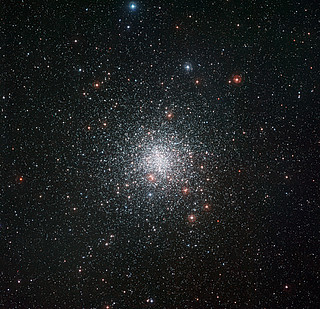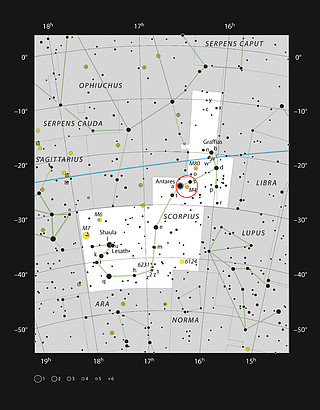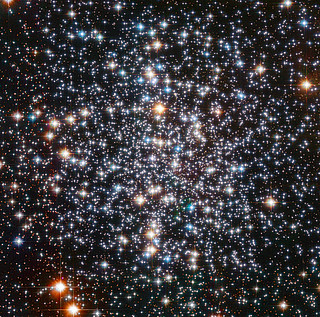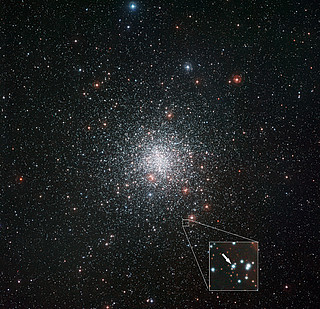5 de septiembre de 2012
Una nueva imagen, captada desde el Observatorio La Silla de ESO en Chile, muestra el impresionante cúmulo globular de estrellas Messier 4. Este grupo constituido por decenas de miles de antiguas estrellas es uno de los más cercanos y uno de los cúmulos globulares más estudiados. Recientes trabajos de investigación han develado que una de sus estrellas posee inusuales y sorprendentes propiedades, aparentemente en ella reside el secreto de la eterna juventud.
Alrededor de la Vía Láctea orbitan más de 150 cúmulos globulares de estrellas que se remontan al distante pasado del Universo (eso1141). Uno de los más cercanos a la Tierra es el cúmulo Messier 4 (también conocido como NGC 6121), localizado en la constelación de Scorpius (El Escorpión). Este objeto brillante puede observarse fácilmente con binoculares, cercano a Antares, una estrella supergigante roja, y un telescopio amateur pequeño puede mostrar algunas de las estrellas que lo constituyen.
Esta nueva imagen, obtenida con el WFI (Wide Field Imager, Cámara de gran campo) del telescopio MPG/ESO de 2,2 metros ubicado en el Observatorio La Silla de ESO, revela un gran número de las decenas de miles de estrellas presentes en el cúmulo, mostrándolo con el esplendor de la Vía Láctea de fondo.
Los astrónomos también han podido analizar por separado muchas de las estrellas de este cúmulo, mediante el uso de diversos instrumentos que forman parte del Telescopio Muy Grande (VLT) de ESO. Al separar la luz de las estrellas en los colores que la componen, ellos pueden medir las edades y composición química de las mismas.
Los nuevos resultados de las estrellas de Messier 4 son sorprendentes. Las estrellas que son parte de los cúmulos globulares son muy antiguas, por lo que no se espera que posean una gran cantidad de elementos químicos pesados [1]. Esto fue precisamente lo que se encontró, sin embargo, en una de las estrellas analizadas recientemente, además se detectó mucha mayor cantidad de litio (raro elemento que pertenece al grupo de los elementos más ligeros) de la esperada. La procedencia de este litio es un misterio. Normalmente este elemento se degrada paulatinamente durante miles de millones de años, a lo largo de la vida de una estrella, pero esta estrella en particular parece guardar el secreto de la eterna juventud. De alguna manera, ha sido capaz de preservar sus niveles de litio originales, o ha encontrado una forma de aumentar sus propios niveles con litio de reciente generación.
Esta imagen del WFI entrega una panorámica del cúmulo, así como de su abundante entorno. Una vista complementaria más detallada exclusivamente de la región central, tomada desde el Telescopio Espacial Hubble (proyecto conjunto de la NASA y de la ESA), también fue publicada esta semana como parte de la serie de Imágenes de la Semana del telescopio.
Notas
[1] La mayoría de los elementos químicos más pesados que el Helio se originan en las estrellas y se dispersan en el Medio Interestelar en los momentos finales de su existencia. Este material con nuevos elementos químicos pasa más tarde a formar los componentes esenciales para futuras generaciones de estrellas. Como resultado, se ha descubierto que las estrellas muy antiguas (como las que se encuentran en los cúmulos globulares) que se generaron antes de que importantes cantidades de elementos químicos fueran liberados, poseen una menor abundancia de elementos pesados cuando se les compara a estrellas como el Sol, que se formaron en etapas posteriores.
Esta es una traducción de la nota de prensa de ESO eso1235.
Imágenes

The globular star cluster Messier 4
This image from the Wide Field Imager attached to the MPG/ESO 2.2-metre telescope at ESO’s La Silla Observatory shows the spectacular globular star cluster Messier 4. This great ball of ancient stars is one of the closest of such stellar systems to the Earth and appears in the constellation of Scorpius (The Scorpion) close to the bright red star Antares.
Credit: ESO Imagen eso1235a

The globular star cluster Messier 4 in the constellation of Scorpius
This chart shows the position of the globular star cluster Messier 4 (also known as NGC 6121) in the constellation of Scorpius (The Scorpion) close to the bright star Antares. This map shows most of the stars visible to the unaided eye under good conditions, and Messier 4 itself is highlighted with a red circle on the image. This bright cluster can be seen with binoculars and is spectacular through a medium-sized telescope.
Credit: ESO, IAU and Sky & Telescope Imagen eso1235b

Wide-field view of the sky around the globular star cluster Messier 4
This wide-field view is centred on the globular star cluster Messier 4 (NGC 6121) in the constellation of Scorpius (The Scorpion). It is a colour composite made from exposures from the Digitized Sky Survey 2 (DSS2). The smaller globular cluster at the upper left is NGC 6144. It is similar to Messier 4, but more than three times further away. The red glow of clouds of hydrogen and associated star formation can also be seen in the upper left corner and the bright star Sigma Scorpii can be seen at the upper right.
Credit: ESO/Digitized Sky Survey 2. Acknowledgment: Davide De Martin. Imagen eso1235c

NASA/ESA Hubble Space Telescope image of the centre of Messier 4
This sparkling picture taken by the NASA/ESA Hubble Space Telescope shows the centre of globular cluster Messier 4. The power of Hubble has resolved the cluster into a multitude of glowing orbs, each a colossal nuclear furnace.
Messier 4 is relatively close to us, lying 7200 light-years distant, making it a prime object for study. It contains tens of thousands of stars and is noteworthy in being home to many white dwarfs — the cores of ancient, dying stars whose outer layers have drifted away into space.
In July 2003, Hubble helped make the astounding discovery of a planet called PSR B1620-26 b, 2.5 times the mass of Jupiter, which is located in this cluster. Its age is estimated to be around 13 billion years — almost three times as old as the Solar System. It is also unusual in that it orbits a binary system of a white dwarf and a pulsar (a type of neutron star).
Amateur stargazers may like to track Messier 4 down in the night sky. Use binoculars or a small telescope to scan the skies near the orange-red star Antares in Scorpius. Messier 4 is bright for a globular cluster but it won’t look anything like Hubble’s detailed image: it will appear as a fuzzy ball of light in your eyepiece.
Credit: ESA/Hubble & NASA Imagen eso1235d

The globular star cluster Messier 4: and the location of a curious star
This image from the Wide Field Imager attached to the MPG/ESO 2.2-metre telescope at ESO’s La Silla Observatory shows the spectacular globular star cluster Messier 4. This great ball of ancient stars is one of the closest of such stellar systems to the Earth and appears in the constellation of Scorpius (The Scorpion) close to the bright red star Antares.
New observations with ESO's Very Large Telescope have revealed that one star — marked on this picture — has much more lithium than the other stars in the cluster that have been studied. The source of this lithium is mysterious. Normally this element is gradually destroyed over the billions of years of a star's life, but this one star amongst thousands seems to have the secret of eternal youth. It has either somehow managed to retain its original lithium, or it has found a way to enrich itself with freshly made lithium.
Credit: ESO Imagen eso1235e
Pinchando en las imáges crecen
Videos
Zooming in on the globular star cluster Messier 4
This video starts with a broad view of the spectacular central parts of the Milky Way. We close in on the constellation of Scorpius (The Scorpion). Close to its brightest star, Antares, lies the globular star cluster Messier 4, one of the closest of these rich stellar systems to the Earth. The final detailed views of the cluster come from the Wide Field Imager attached to the MPG/ESO 2.2-metre telescope at ESO’s La Silla Observatory in Chile followed by a close up of the central region from the NASA/ESA Hubble Space Telescope.
Credit:
ESO/ESA/NASA/Digitized Sky Survey 2/Nick Risinger (skysurvey.org)
Acknowledgement: ESO Imaging Survey
Music: Disasterpeace Video eso1235a
Panning across the globular star cluster Messier 4
This video gives a close-up view of a new image from the Wide Field Imager attached to the MPG/ESO 2.2-metre telescope at ESO’s La Silla Observatory showing the spectacular globular star cluster Messier 4. This great ball of ancient stars is one of the closest such stellar systems to the Earth and appears in the constellation of Scorpius (The Scorpion) close to the bright red star Antares.
Credit: ESO
Music: Disasterpeace Video eso1235b
Salu2 a tod@S




